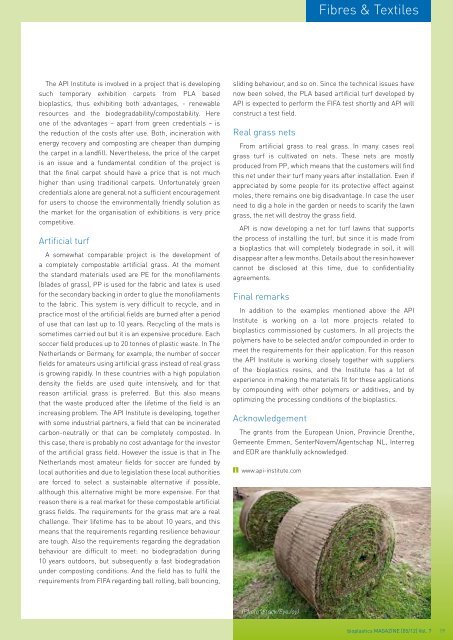bioplasticsMAGAZINE_1205
bioplasticsMAGAZINE_1205
bioplasticsMAGAZINE_1205
Create successful ePaper yourself
Turn your PDF publications into a flip-book with our unique Google optimized e-Paper software.
Fibres & Textiles<br />
The API Institute is involved in a project that is developing<br />
such temporary exhibition carpets from PLA based<br />
bioplastics, thus exhibiting both advantages, - renewable<br />
resources and the biodegradability/compostability. Here<br />
one of the advantages – apart from green credentials – is<br />
the reduction of the costs after use. Both, incineration with<br />
energy recovery and composting are cheaper than dumping<br />
the carpet in a landfill. Nevertheless, the price of the carpet<br />
is an issue and a fundamental condition of the project is<br />
that the final carpet should have a price that is not much<br />
higher than using traditional carpets. Unfortunately green<br />
credentials alone are general not a sufficient encouragement<br />
for users to choose the environmentally friendly solution as<br />
the market for the organisation of exhibitions is very price<br />
competitive.<br />
Artificial turf<br />
A somewhat comparable project is the development of<br />
a completely compostable artificial grass. At the moment<br />
the standard materials used are PE for the monofilaments<br />
(blades of grass), PP is used for the fabric and latex is used<br />
for the secondary backing in order to glue the monofilaments<br />
to the fabric. This system is very difficult to recycle, and in<br />
practice most of the artificial fields are burned after a period<br />
of use that can last up to 10 years. Recycling of the mats is<br />
sometimes carried out but it is an expensive procedure. Each<br />
soccer field produces up to 20 tonnes of plastic waste. In The<br />
Netherlands or Germany, for example, the number of soccer<br />
fields for amateurs using artificial grass instead of real grass<br />
is growing rapidly. In these countries with a high population<br />
density the fields are used quite intensively, and for that<br />
reason artificial grass is preferred. But this also means<br />
that the waste produced after the lifetime of the field is an<br />
increasing problem. The API Institute is developing, together<br />
with some industrial partners, a field that can be incinerated<br />
carbon-neutrally or that can be completely composted. In<br />
this case, there is probably no cost advantage for the investor<br />
of the artificial grass field. However the issue is that in The<br />
Netherlands most amateur fields for soccer are funded by<br />
local authorities and due to legislation these local authorities<br />
are forced to select a sustainable alternative if possible,<br />
although this alternative might be more expensive. For that<br />
reason there is a real market for these compostable artificial<br />
grass fields. The requirements for the grass mat are a real<br />
challenge. Their lifetime has to be about 10 years, and this<br />
means that the requirements regarding resilience behaviour<br />
are tough. Also the requirements regarding the degradation<br />
behaviour are difficult to meet: no biodegradation during<br />
10 years outdoors, but subsequently a fast biodegradation<br />
under composting conditions. And the field has to fulfil the<br />
requirements from FIFA regarding ball rolling, ball bouncing,<br />
sliding behaviour, and so on. Since the technical issues have<br />
now been solved, the PLA based artificial turf developed by<br />
API is expected to perform the FIFA test shortly and API will<br />
construct a test field.<br />
Real grass nets<br />
From artificial grass to real grass. In many cases real<br />
grass turf is cultivated on nets. These nets are mostly<br />
produced from PP, which means that the customers will find<br />
this net under their turf many years after installation. Even if<br />
appreciated by some people for its protective effect against<br />
moles, there remains one big disadvantage. In case the user<br />
need to dig a hole in the garden or needs to scarify the lawn<br />
grass, the net will destroy the grass field.<br />
API is now developing a net for turf lawns that supports<br />
the process of installing the turf, but since it is made from<br />
a bioplastics that will completely biodegrade in soil, it will<br />
disappear after a few months. Details about the resin however<br />
cannot be disclosed at this time, due to confidentiality<br />
agreements.<br />
Final remarks<br />
In addition to the examples mentioned above the API<br />
Institute is working on a lot more projects related to<br />
bioplastics commissioned by customers. In all projects the<br />
polymers have to be selected and/or compounded in order to<br />
meet the requirements for their application. For this reason<br />
the API Institute is working closely together with suppliers<br />
of the bioplastics resins, and the Institute has a lot of<br />
experience in making the materials fit for these applications<br />
by compounding with other polymers or additives, and by<br />
optimizing the processing conditions of the bioplastics.<br />
Acknowledgement<br />
The grants from the European Union, Provincie Drenthe,<br />
Gemeente Emmen, SenterNovem/Agentschap NL, Interreg<br />
and EDR are thankfully acknowledged.<br />
www.api-institute.com<br />
(Photo iStock/EyeJoy)<br />
bioplastics MAGAZINE [05/12] Vol. 7 19


















